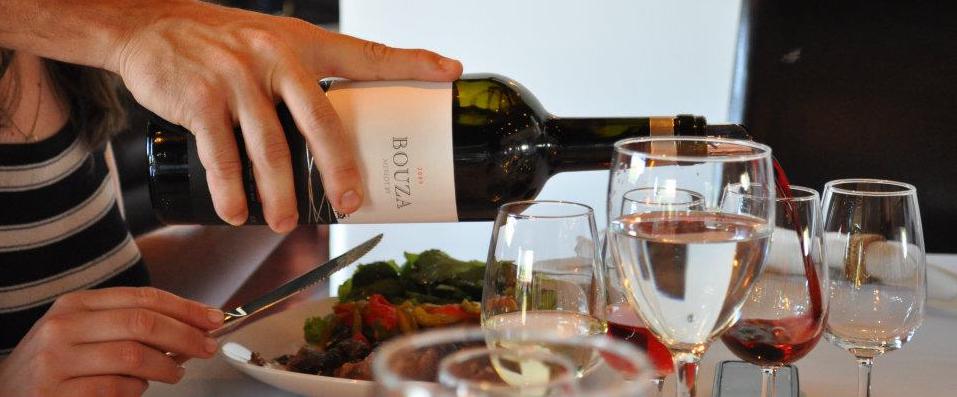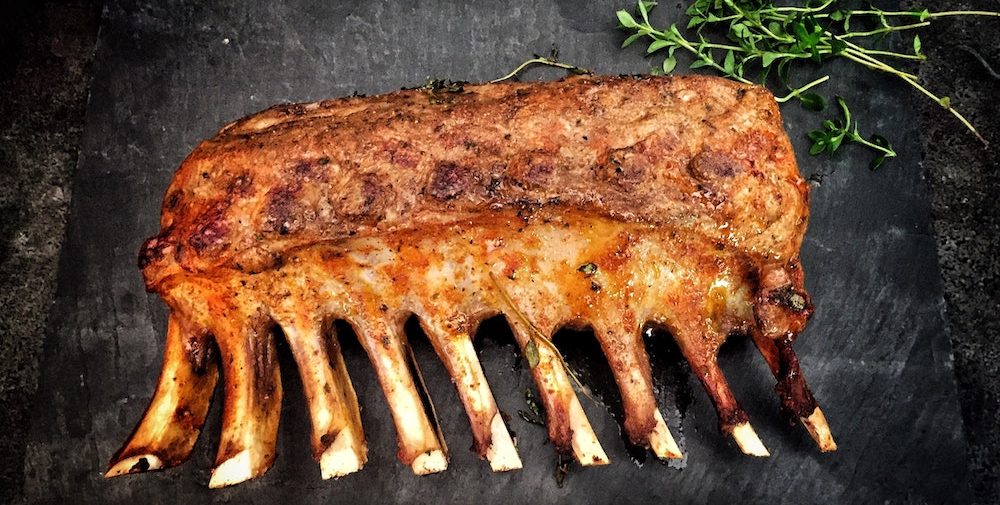When it comes to pairing food with Uruguayan wine, more often than not we are looking at pairing food with Tannat. And the most local and ultimate Uruguay wine pairing is Tannat and beef. Why? Because Uruguay produces more Tannat than anywhere else in the world and consumes more beef than anywhere else in the world.
For such a small country, the numbers are quite staggering. Uruguay produces over a third of the world’s Tannat with some 1,655 hectares planted. But far more staggering, in Uruguay, cows outnumber humans 4 to 1! Uruguayans consume more beef per capita than any other country in the world (at a whopping great 124lbs per person). So the pairing of Tannat and beef comes quite naturally, however, that’s not all Uruguay has to offer in food and wine pairings.
Pairing Tannat wines from Uruguay
Tannat is Uruguay’s champion grape which means it is planted all over Uruguay’s wine regions. With wine regions ranging from coastal to subtropical and over 99 classified soil types in Uruguay, Tannat wines from different vineyards can have quite distinctive styles.
From the heavier clay soils and temperate climate of Canelones, you tend to find much more complex and structured Tannat wines. Whereas Tannat wines from the poor, granitic soils of Maldonado where coastal breezes are cooler, you tend to find Tannat wines that have higher acidity and fresher fruit aromas.
There are also significant differences in winemaking between the different producers in Uruguay. The different uses of oak barrels, stainless steel and concrete tanks all impact the final wine and there are also a great range of harvest times and vinification techniques. In Uruguay, you’ll find bright and juicy Tannats with zero oak influence (including a sparkling Tannat) and you’ll also find dense and complex styles and even dessert wines (including a Tannat Ripasso!)
Different styles of wine = different Tannat food pairings
This all means that Tannat will pair with a range of dishes on the table. Take Pisano‘s Rio de los Pajaros Tannat or Pizzorno‘s carbonic maceration Don Próspero Tannat as an example. These wines are bright, fruit-driven with lively acidity and a tickle of tannin to give some structure. This lighter style of Tannat is enjoyable with red pasta dishes, with charcuterie and lighter meats on the BBQ.
The richer, more complex style of Tannat, from Canelones in particular, which has spent time in barrel – such as Familia Carrau‘s Juan Carrau Reserva or Amat, De Lucca‘s Tannat blends, Marichal‘s Tannat A or Varela Zarranz‘s Guidai Deti blend – needs an altogether stronger pairing. The bold tannins of Tannat deserve a dish with fat and richness, and the dark character of tannat works well with smoky, spiced and meaty flavours. Grilled meats (whether beef, pork, lamb or game) can pair excellently with Tannat wines of this style, as can strong cheeses and wild mushrooms.
The new coastal Tannat wines from Maldonado region tend to have fresher fruit aromas (think red fruit rather than black) and some brightness in the palate, often accompanied by winemaker preferences to use concrete over oak. Good examples of this would be the Tannat wines of Bodega Garzón, Familia Deica‘s Valle de los Manantiales and Bouza‘s Tannat from Pan de Azucar.
These Tannat wines are energetic with vibrancy in the palate and nose and are versatile for food pairings. These wines pair particularly well with flavourful meats without as much fat (like roast lamb cutlets, fillet steak and duck) and work nicely with hard, aged cheeses.
Pairing other Uruguayan wines with food
Of course, Uruguay doesn’t only have Tannat on the table. There’s a wide range of different varieties grown in Uruguay which have been brought from different European immigrants over the years. Uruguay is a country of small, family wineries and each family has brought different varieties from different regions around the world where they have family bonds.
You’ll find Arneis (Viñedo de los Vientos), Zinfandel (Artesana), Nero d’Avola (De Lucca), Albariño (Bouza), Petit Mensang (Bodega Cerro Chapeu), Sangiovese (Viña Progreso), Verdejo (El Capricho)… the list goes on! Often these different varieties are blended with Tannat – for example, Marichal makes a great Pinot Noir-Tannat blend, and Alto de la Ballena blends their Tannat with Viognier and Cabernet Franc in different wines.
Each wine obviously has its own personality and needs a customised pairing. However, here are some of my favourite pairings for Uruguayan dishes with some Uruguayan wines:
Some key pairings for Uruguayan food with Uruguayan wine
Wine pairing for Asado

Juicy meat that’s dripping with fat and smokey from the coals is crying out to be paired with a good Tannat. Try a more complex style of Tannat (see recommendations above).
What to drink with Uruguayan Chivito

A nation of pasta – and the inventor of Cappelletti a la Caruso

Caruso pasta sauce is made from cream with nuts, mushrooms, ham and cheese. It is often served with stuffed cappelletti (also spelt capeletis). These small pasta shells are usually stuffed with some sort of meat (normally beef) but it is the sauce that carries most of the flavour and is what you should be pairing with.
For me, this Uruguayan dish calls for one of the excellent Albariño wines coming from Uruguay (try Bouza or Garzón) which offsets the creaminess with its refreshing acidity. Or try an Arneis (Viñedo de los Vientos), a Marsanne (De Lucca) or Petit Mensang (Bodega Cerro Chapeu) for a more complex and full-bodied wine pairing.
–
Uruguayan stews

Revuelto Gramajo

What are your favourite Uruguayan wine pairings?
On Saturday 9th February, the South America Wine Guide is collaborating on a live Uruguayan Wine Pairing Weekend. You can join the discussion over Twitter and share your favourite pairings for wines from Uruguay.
Key food and wine bloggers who are participating in this discussion are:
- Gwendolyn Alley, Wine Predator @artpredator
- Jill Barth @jillbarth
- Jeff Burrows, Food, Wine, Click @foodwineclick
- David Crowley, Cooking Chat Food @cookingchat
- Wendy Klik, A day in the life on the farm @wendyklik
- Camila Mann, Culinary Adventures with Cam @culinary_cam
- Jennifer Martin, Vino Travels Italy @vinotravels21
- Jane Niemeyer, Always Ravenous @always_ravenous
- Sarah Ozimek, Curious Cuisine @CCuisiniere
- Martin Redmond, Enoflyz Wine Blog @martindredmond
- Cindy Rynning, Grape Experiences @GrapeExp_Cindy
- Rupal Shankar, Syrah Queen @Syrah_Queen
- Michelle Williams, Rockin Red Blog @Fiery01Red
- Kat Wisnosky, Baccus Travel and Tours
- Amanda Barnes, South America Wine Guide @Squeeze_Mag
Follow the conversation on #WinePW and add your own favourite Uruguay wine pairings from 11am ET. In case you want to taste the same Uruguayan wines as the bloggers, we’ll be tasting:
1752 Gran Tradicion Petit Mensang Bodega Cerro Chapeu
(Download technical sheet.)
This is one of Uruguay’s only Petit Manseng wines and Francisco Carrau planted it in Melilla, Canelones. Rich, full-bodied and with notes of hay, honey and citrus peel.
Aguará Special Reserve Tannat, El Capricho
(Download technical sheet.)
El Capricho is a new winery in the Durazno region of Uruguay, focused on making premium wines from their sandstone soil vineyards. This Tannat shows ripe berry aromas and fleshy fruit notes and has approachable tannins with some exotic spice following barrel ageing.
Tannat-Viognier, Alto de la Ballena
(Download tech sheet.)
The original pioneers of Maldonado, this small family winery makes top notch red wines and this Tannat-Viognier blend is one of their trademarks. Red fruit notes, meadow flowers and spice on the nose with plummy flavours and spicy tannins.
Albariño, Bodega Garzón
(Download tech sheet.)
This new coastal vineyard and winery have made a real splash in Uruguay and their Albariño is one of the preferred white wines sold in glamorous Punta del Este. Fresh with vibrant notes of peach, tropical fruit and blossom, the finish is saline and mouthwatering.
Single Vineyard Tannat, Bodega Garzón
(Download tech sheet.)
Coming from granitic soils close to the coast, there’s a real freshness and elegance to this Tannat. Aromas of fresh red berries mix with spice and cigar box to reveal a complex wine, which remains lively on the finish.
Reserve Tannat, Bodega Cerro Chapeu
(Download tech sheet.)
From the unique terrain of Cerro Chapeu, near the border of Brazil in Rivera, these Tannat vines grown on deep, red soils produce wines of smoother and well-matured tannins. Full but fleshy, notes of red fruit and plum dominate.
B6 Tannat, Bouza
(Download tech sheet.)
B6 is one of Bouza’s single lot wines (also called parcel unica), in this case coming from lot B6. This rich and complex Tannat comes from their vineyard in Las Violetas, which is a prized sub-region of Canelones.
Albariño, Bouza
(Download tech sheet.)
Bodega Bouza was the first winery in Uruguay to produce Albariño, inspired by Elisa Bouza’s Galician heritage. This bright and aromatic Albariño has notes of peach, pineapple and blossom, with a long and fresh finish. It has become an icon of Uruguayan white wines today.
Reserve Pinot Noir-Tannat, Marichal
(Download tech sheet.)
Juan Andrés Marichal did something no-one had ever done before – he blended one of the world’s most tannic red grapes with one of the world’s least tannic red grapes, Tannat and Pinot Noir. The combination results in an interesting wine with fleshy fruit notes and some spice.
Reserve Collection Tannat, Marichal
(Download tech sheet.)
This is a classic Tannat from the Marichal family in Canelones with ripe red and black fruit notes and spicy aromas. In the palate it is full-bodied with expressive fruit and grippy tannins.
Pedregal Tannat, Antigua Bodega Stagnari
(Download tech sheet.)
This Tannat comes from a sixth-generation winemaking family in Canelones. With just six months in oak barrel, this wine retains lots of black fruit notes alongside aromas of spice and vanilla. This is their classic line and offers great value.
Prima Donna Tannat, Antigua Bodega Stagnari
(Download tech sheet.)
This wine is a homage to all the women who work in this historic, family winery. It has jammy aromas of berries and plums alongside some spice and chocolate notes.
Do you have a favourite Tannat wine pairing? Or a favourite Uruguayan wine? Tell us all about it over Twitter on 9th February. We’ll be participating from our Twitter account: @Squeeze_Mag


